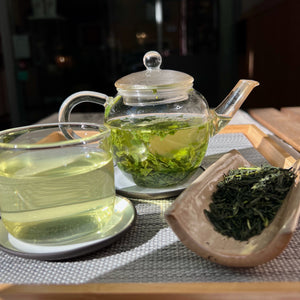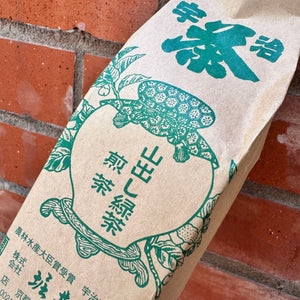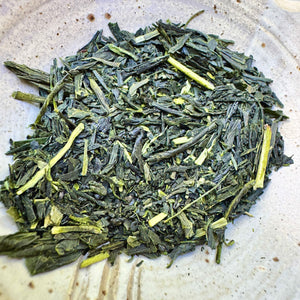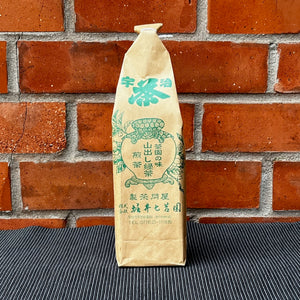
Yamadashi Sencha (aracha)
Tax included
Shipping calculated at checkout
Out of stock
Pickup currently unavailable
Yamadashi Sencha – Shichimeien, Uji • “raw charm, mountain freshness”
Yamadashi is Shichimeien's classic Uji-sencha, offered in aracha (partially refined) form: in addition to the leaf, the buds, stems and smaller parts are also present, so the tea retains the immediacy and "raw charm" of the mountain gardens. This gives it a full, yet fresh character and a long, clean finish. (Source: manufacturer's description)
Origin & style
- Region: Uji, Kyoto – the historical center of Japanese tea.
- Producer: Horii Shichimeien – a long-established tea producer linked to the heritage of the “Seven Famous Uji Tea Gardens”.
- Style: Yamadashi (mountain picking), aracha -like – direct, juicy, energetic profile. Sencha before sorting.
Processing in brief
Freshly picked in spring, steamed ( asamushi–chumushi range), cooled and gently rolled, then dried. In the aracha style, the tea is not fully post-sorted and “beautified” – giving it a fuller, more layered flavor.
Flavor profile
- Aroma: fresh grass, young leaves, slight sweet-nutty nuance.
- Taste: full, yet fresh sip; green herbal sweetness, white almond and algae-mineral line, delicate umami.
- Finish: clean, cool sensation, long, sweet aftertaste.
Recommended preparation
Japanese (kyusu) method
- 5 g tea / 200 ml soft water
- 70–75°C
- 1st pour: 60–90 sec • 2nd: 15–20 sec • 3rd: 45–60 sec
Western method
- 3g tea / 250ml
- 75–80 °C, 1.5–2 minutes • 2nd pour: +30–40 seconds
Cold brew / cold soak
- 8–10 g tea / 1 liter
- Refrigerate for 6–8 hours
- Result: a crystal clear, sweet-green, refreshing cup.
Pairing & occasion
- Perfect for light desserts (yuzu mousse, matcha cookies), sushi or fresh cheeses.
- For morning focus, afternoon “reboot”.
Note: The proportions are a guide; water quality and cup/gaiwan/kyusu size may require fine-tuning.

Personal contact
Our teas don't come from wholesale warehouses or unknown sources. We travel to the small producers we source from – whether it's a Japanese family tea garden, a Chinese mountain village or an oolong maker in Taiwan.
Stories
We meet them in person, learn their story, see how they care for their plants, and how they process the fresh leaves.
These experiences are the soul of our teas. This way, not only is the quality guaranteed, but also the fact that behind each cup there is a real person, a real story.


Direct
This direct relationship is valuable to us. Not only because of the excellent tea, but because we believe that trust, respect and personal presence are what make the tea drinking experience truly special.
Teavolution Tea Blog
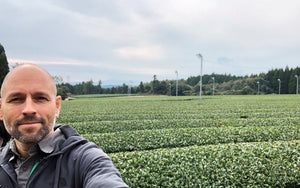
Oct 2, 2025
Sencha tea
Read more

Sep 21, 2025
Matcha hiány Japánban
Read more
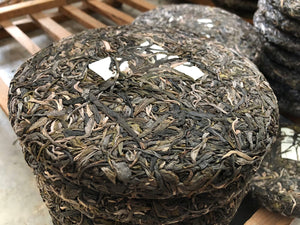
Mar 18, 2025
Puer tea, puerh or pu-erh
Read more
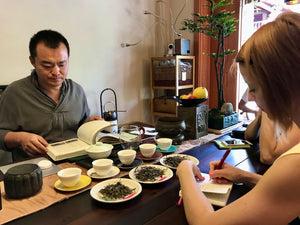
Mar 18, 2025
Types of tea
Read more
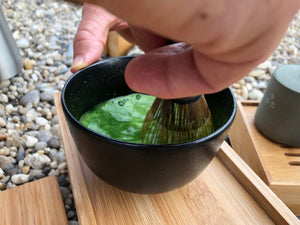
Mar 18, 2025
What is matcha tea?
Read more

Mar 18, 2025
Oolong tea (Wulong tea)
Read more

